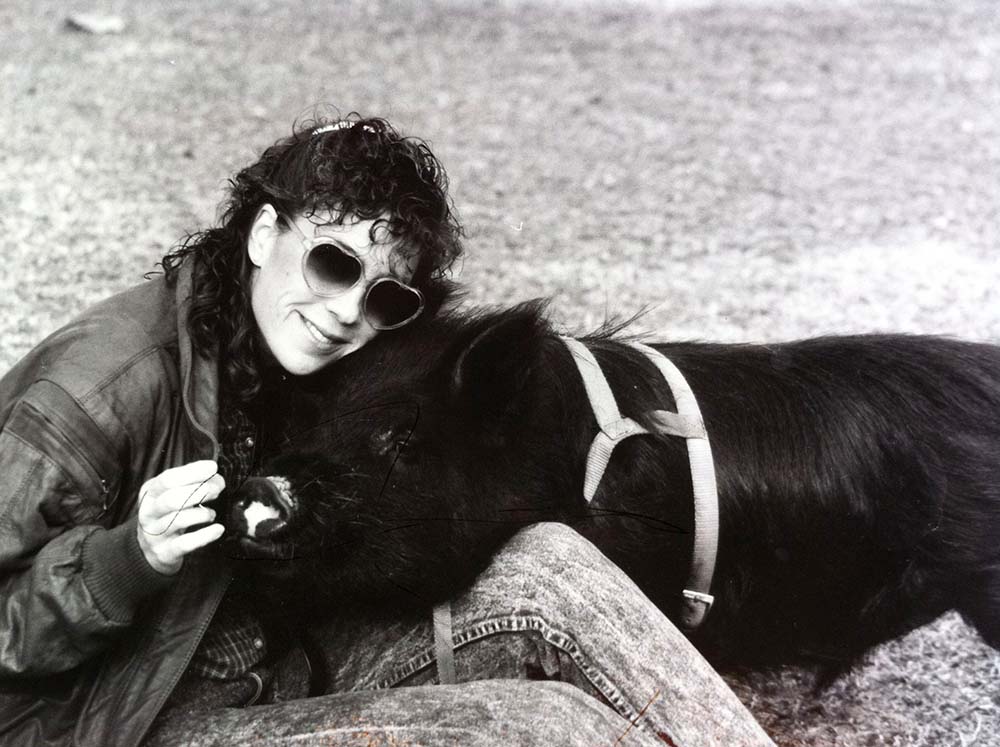Sporky the Pig
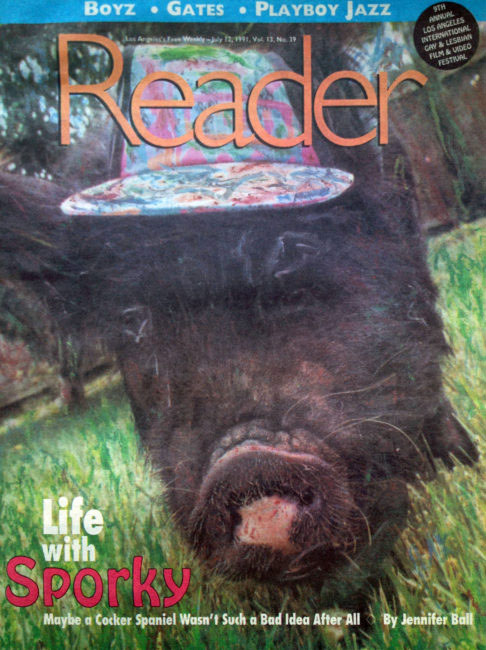 My pig discovered glass today. He understood that there was some insurmountable clear space which he didn’t understand, nor could he get through. Nothing more complicated than a sliding glass door to you and me, but to a pig, a trick, an obstacle that prevented him from doing the thing he did best: eat. As I stood watching my pig push and push on the glass and then finally move away from the door, I could see that he was pouting, pretending not to care. Because he could see me but was not able to root on me (the thing he did second best), he felt hurt. So he sat down on his haunches, his usual begging position, and waited. Feeling like an unfeeling human being, I slid the door open and then quickly stood aside for his immediate take-off down the plastic runway into the kitchen where he knew his food bowl awaited him. Compared to dinner, the discovery of glass was inconsequential.
My pig discovered glass today. He understood that there was some insurmountable clear space which he didn’t understand, nor could he get through. Nothing more complicated than a sliding glass door to you and me, but to a pig, a trick, an obstacle that prevented him from doing the thing he did best: eat. As I stood watching my pig push and push on the glass and then finally move away from the door, I could see that he was pouting, pretending not to care. Because he could see me but was not able to root on me (the thing he did second best), he felt hurt. So he sat down on his haunches, his usual begging position, and waited. Feeling like an unfeeling human being, I slid the door open and then quickly stood aside for his immediate take-off down the plastic runway into the kitchen where he knew his food bowl awaited him. Compared to dinner, the discovery of glass was inconsequential.
I bought a pig because I wasn’t yet ready for children. I wanted something small and helpless, but something which wouldn’t require college or “quality time.” I figured, if the pig didn’t work out, we could always have dinner. That’s not an option with children.
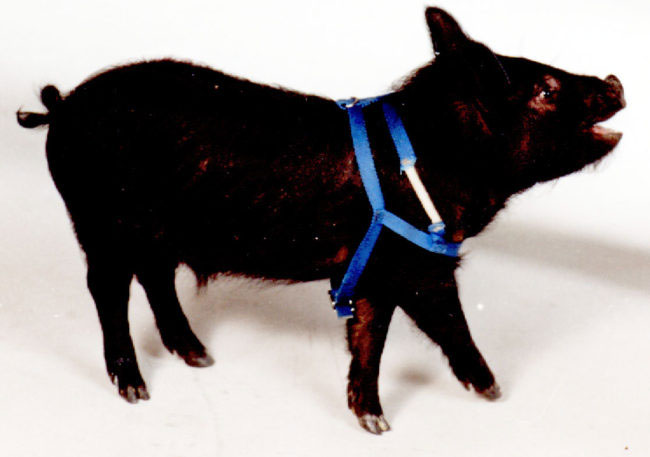
As it turns out, there’s a lot of things they don’t tell you when you buy a miniature pig. For example, they don’t mention anything about rooting. Now, most people, if they thought about it for awhile, would probably recall that pigs do indeed root. But a simple word like “root” doesn’t adequately encompass the total interest that pigs devote to the earth. For instance, a novice like I used to be might think that they only root in France when looking for truffles. And I even did research before I bought this pig. (My husband made me.) There I was with the encyclopedias, taking down notes about their favorite foods and their favorite places to be scratched (and the favored method of preparation), but nowhere do I have any scribbled account that mentions rooting. And now, with half the linoleum gone from our kitchen, it seems that it might have been an important point to have noted.
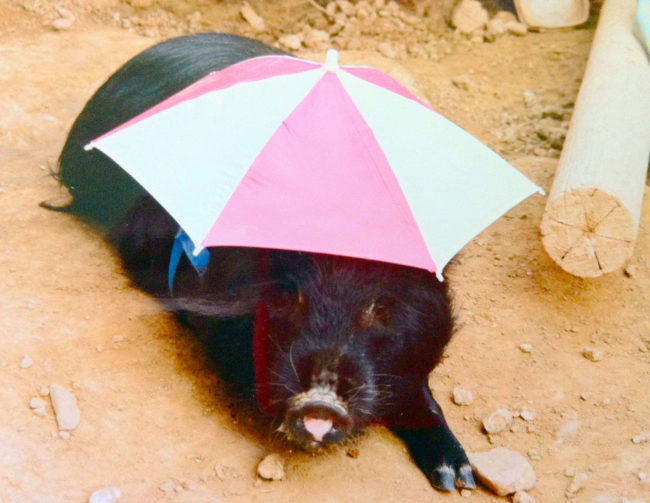
The pig farm did send us some literature, but the literature also never mentioned anything about a pig’s “airspace.” This could simply be because airspace is a much more common term in San Diego than it is in Georgia. I myself was unaware of the term until a friend said to me the other day that she and her family almost got a ticket over the weekend. I knew that they had spent the weekend in the desert, an odd place to attract the attention of the authorities I thought. I asked her what happened.
“Oh, it started with the police flying by in their helicopters, but my father told them that they were in a private airspace and had better leave.”
I put the expression “private airspace” away in my brain where I store such words as “power tools,” “fecal material,” and “high-octane pig starter” (Sporky’s recommended pig chow). I think of these words as immediate attention-getters. These are the kinds of words comedians use. I know. I used to date one.
My friend’s father was the co-founder of a microchip company and is, consequently, quite wealthy. I suppose those kind of people can use terms like “private airspace” without feeling a trifle smarmy.
“So did you get a ticket?” I finally asked, not really wanting to prompt her.
“They tried to give us a ticket for riding quads.”
I already had had explained to me that quads are these sort of motorized tricycle-looking things. Although the tricycle ones (with three wheels) have been outlawed. Quads, logically, have four wheels, and I suppose that makes them a little more steadfast.
“Why would they give you a ticket for riding quads?”
“Oh, they were mad because we were riding through a national park.” She made a tching sound of incredible disgust.
“Is that illegal?” I asked casually.
“They just recently made it illegal.”
“Why is that?”
“Oh, they think it causes erosion.”
“Does it?”
“No! When the rains come, it washes all the tire tracks away.”
These are the kind of conversations that make me want to own a pig in San Diego if only to educate the sheltered individuals who live here that there is a big world out there and maybe they should take a peek at it (along with the dictionary). Because of this exchange, I now think of everything within pig reach as “Sporky’s private airspace.” For example, the vacuum cord was hanging there, taunting him, in Sporky’s private airspace, so he chomped it. He has a right to anything in his airspace for the simple reason that he will take it. Pigs aren’t creatures to hold back their emotions or their curiosity. “Pigs are very intelligent,” people often say to me. “Ah!” I say wisely (as I imagine Confucius might have done). “Intelligence isn’t necessarily something you want in a pet.” Obviously, they haven’t had a smart enough animal to realize this. Sporky has managed to open every kitchen cabinet despite the double child-proof locks (spilling food coloring all over the kitchen floor and then proceeding to walk through it perhaps a hundred times) and I wonder, is it intelligence or simply persistence? If I had a sledgehammer for a nose, what havoc would I wreak?
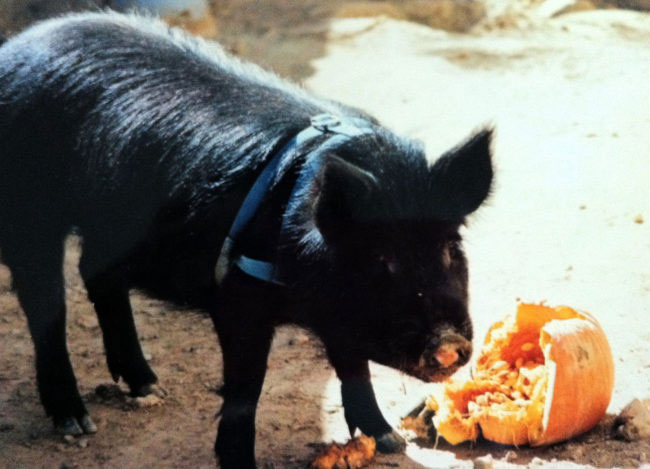
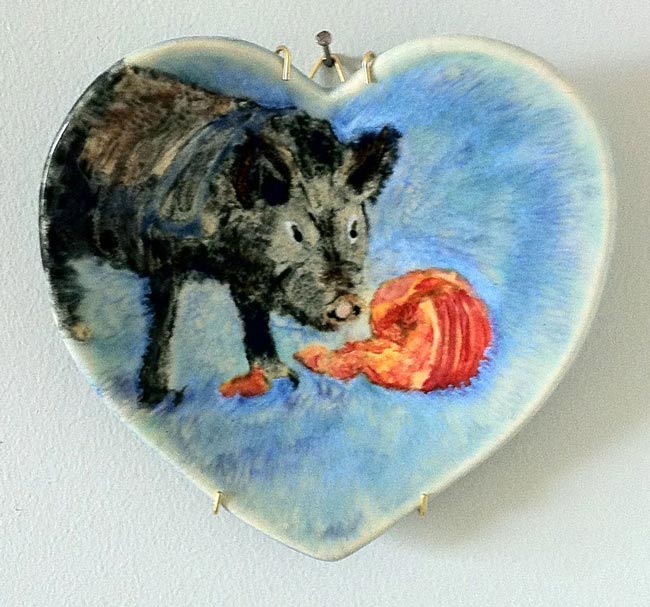
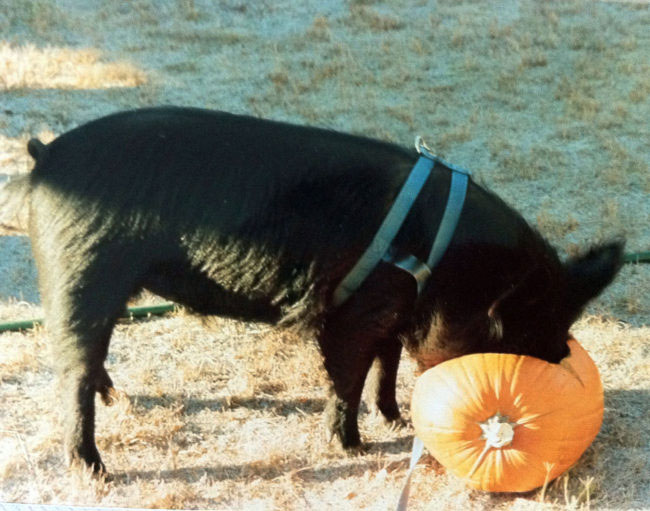 Though the encyclopedias I consulted proved to be somewhat lacking in pertinent information, they did have other interesting trivia. (I say trivia in deference to the non-pig owner; for myself, I now consider it essential information.) One source said that pigs don’t sweat and one said that they sweat through their nose. (I trust the second reference: they do everything through their noses.) In fact, the reason why pigs have the reputation of rolling in the mud—over eighty-five degrees and they’ll even roll in their own excrement to cool off—is because of their limited ability to sweat. The pig farm I bought him from recommended buying a small pool for the pig. I went to a toy store in December. (We got him in November.) They looked at me strangely and said that pools won’t be in until summer. I mean we live in San Diego for God’s sake. What good is living in San Diego if you can’t buy a swimming pool for your pig year round?
Though the encyclopedias I consulted proved to be somewhat lacking in pertinent information, they did have other interesting trivia. (I say trivia in deference to the non-pig owner; for myself, I now consider it essential information.) One source said that pigs don’t sweat and one said that they sweat through their nose. (I trust the second reference: they do everything through their noses.) In fact, the reason why pigs have the reputation of rolling in the mud—over eighty-five degrees and they’ll even roll in their own excrement to cool off—is because of their limited ability to sweat. The pig farm I bought him from recommended buying a small pool for the pig. I went to a toy store in December. (We got him in November.) They looked at me strangely and said that pools won’t be in until summer. I mean we live in San Diego for God’s sake. What good is living in San Diego if you can’t buy a swimming pool for your pig year round?
Everyone claims (especially the people at the pig farm) that pigs are very clean animals. That is, I interpret, clean on a sliding scale of ten being not befouling their sleeping area and one being rolling in excrement. I have standards of cleanliness that go off that chart. Not befouling my sleeping area means not eating crackers in bed. Any animal that lives to root cannot be nearly as clean as an animal that perpetually washes itself with its tongue. But I’m allergic to those animals. So one learns to accept a lower standard, and ventures the occasional bath. Giving a pig a bath is an unusual situation and the people who sold me the pig don’t address it at all which leads me to think that they must have a much lower standard of cleanliness than I, making it logical that they would call the pig a clean animal, being pigs themselves.
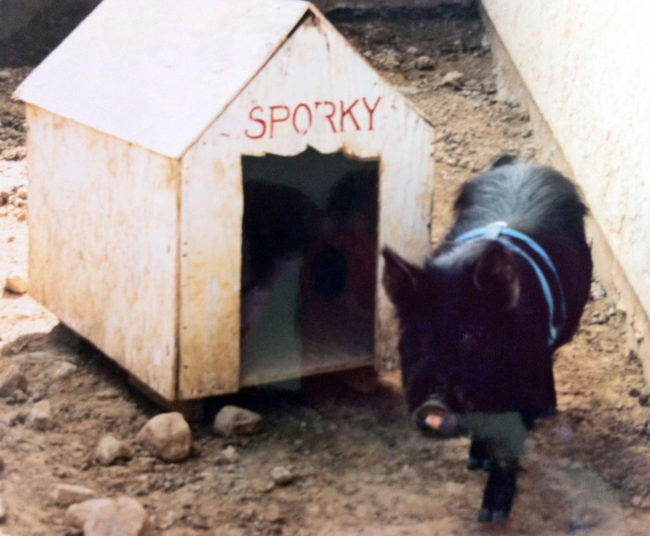 The first thing to do when giving the pig a bath is to close the door once he’s in the bathroom. The need to close the door is indicative of how much pigs like to be bathed. I then move the garbage out of pig reach, start the water, and throw a banana in the tub. Now I lift Sporky, screaming and writhing (let it be known that pigs can scream like you wouldn’t believe—something they never showed you on “Green Acres”) into the tub, and then, as he fights to get out with the banana (in the peel) in his mouth, I pull the knob for the shower and push him into the spray. Long black hairs, flakes of dandruff, and more dirt than I would want in my bed funnel toward the drain. Still squealing as if I were murdering him, he lunges toward the edge; I push him back and then lather him up with Selsun Blue. Pigs can have the worst dandruff in the world. The literature tells you to feed them peanut oil and rub lotion into their skin, but it seems to have little effect. I know that pigs have really similar skin to humans because I read in one encyclopedia that they use pig skin for burn victims. (My husband, the chemist, also informs me that it is very common to use pigs for testing new topical drugs.) I figured that dandruff shampoo couldn’t hurt (though I don’t have any statistics on this so don’t sue me if you try it with your own pig) and it actually seems to help. What a nice soft pig he is after a bath. The bathroom looks like hell, but the pig is a sweetheart pig.
The first thing to do when giving the pig a bath is to close the door once he’s in the bathroom. The need to close the door is indicative of how much pigs like to be bathed. I then move the garbage out of pig reach, start the water, and throw a banana in the tub. Now I lift Sporky, screaming and writhing (let it be known that pigs can scream like you wouldn’t believe—something they never showed you on “Green Acres”) into the tub, and then, as he fights to get out with the banana (in the peel) in his mouth, I pull the knob for the shower and push him into the spray. Long black hairs, flakes of dandruff, and more dirt than I would want in my bed funnel toward the drain. Still squealing as if I were murdering him, he lunges toward the edge; I push him back and then lather him up with Selsun Blue. Pigs can have the worst dandruff in the world. The literature tells you to feed them peanut oil and rub lotion into their skin, but it seems to have little effect. I know that pigs have really similar skin to humans because I read in one encyclopedia that they use pig skin for burn victims. (My husband, the chemist, also informs me that it is very common to use pigs for testing new topical drugs.) I figured that dandruff shampoo couldn’t hurt (though I don’t have any statistics on this so don’t sue me if you try it with your own pig) and it actually seems to help. What a nice soft pig he is after a bath. The bathroom looks like hell, but the pig is a sweetheart pig.
I have a lot of names for that pig, Sweetheart Pig being one of them. Mr. Piggly, Pigwer, Troublemaker Pig (that’s for when he tears through the garbage and leaves it strewn on the floor—he got himself trapped in the bathroom once and chomped through every single one of my used tampons and then pottied on my bra), are all names I call him, but his real name is Sporky which we settled on after someone told us that Spork is a meat product similar to Spam. They saw it at a grocery store in North Carolina. I wanted to call him Vienna because he’s a miniature pig, and my husband wanted to call him Gigantor after the cartoon, you know, “Gi-gan-tor, bigger than big, stronger than strong . . .” I felt fairly unmoved by the song, but I think it must be one of those male-child-in-the-sixties things.
I have a friend who also bought a miniature pig from the same company. She named her pig Frances. (Think about breakfast and the seventeenth century for a moment.) We got our pigs together on a pig date the other day, and though we had a great time walking through a valley of nasturtiums, the pigs couldn’t seem to lose their territorial bent, despite the fact that this wasn’t even their territory. When close to each other, they would chomp their jaws for about a minute. Then they would foam at the mouth for another minute as if they had rabies. While this was going on, the hair on their backs would begin to rise. And after all this had transpired, they would then align like magnets and start to go after each other, but we had them on leashes and wouldn’t let them. (Not till we have the video camera rolling.)
My friend and I had entertained the idea that we might pig-sit for each other during summer vacations, but this put a bit of a damper on the idea. I called the Georgia pig farm and asked them what to do. I was told, “Oh, honey, they’ll go after each other, but they sure won’t kill each other. One might just bite a hole in the other’s ear.” When I told my friend this, she gasped. And I can’t blame her. One chomp and there goes a significant investment.
The pig people did say that after a fight or two, they’d be the best of friends. They just need to learn who’s dominant. I would have sworn that it would be Sporky, but Frances was the definite victor. (She’s got some significant weight on him. We keep Sporky on a strict diet because we don’t want to alarm the neighbors. We told them that he’s a miniature pig, but now that he’s 108 pounds—we weighed him when we were really drunk—we seem to have lied. Now don’t you go thinking he’s a hog—hogs are 120 pounds, thank you.)
Eventually the pigs did six rounds. Poor Sporky was a mama’s boy. He kept trying to hide behind my legs. But hey, he doesn’t have those feisty hormones running through his body anymore and no doubt he’s wondering why.
Pigs are not the most athletic of animals, so after each round of a minute or less, they would retire to opposite sides of the yard for ten to fifteen minutes. We took this opportunity to share in pig lore. For example, Frances’ owners asked us if Sporky had ever eaten anything that we thought would kill him. They told us that Frances ate part of a peanut butter jar once. With the peanut butter of course. That made the glass go down easier. See, Frances knows how to open the refrigerator. They said they thought that she had also eaten Drano. I asked them why they kept Drano in the refrigerator.
When Frances came to visit, she was kind enough to show Spork how to do the refrigerator trick. The thing is, in our house, the freezer is on the bottom. One night I walked in the kitchen, the freezer door was open and both pigs were staring into it trying to figure out what to steal. The only way they know what’s good is through their noses. Since everything was frozen, they couldn’t smell anything. It was like they were watching pig TV.
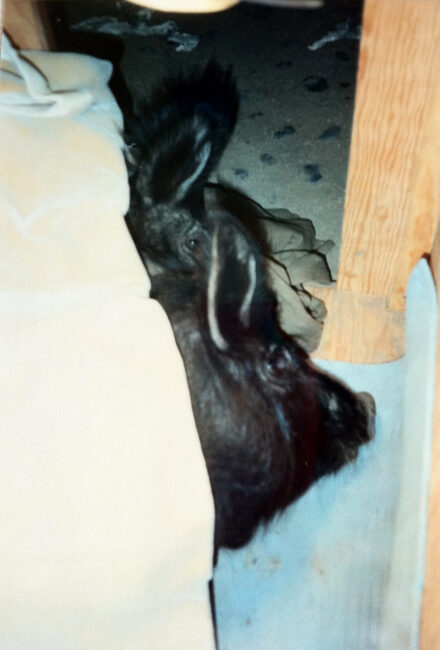 Frances’ owners also brought up the fact that when you take a miniature pig for a walk, you must be prepared to be bombarded with questions like, “Is that a pig?” (I now say that Spork is a dog that just looks like a pig.) “Can I pet him?” “What does he eat?” (My husband likes to tell people that if you cut off Spork’s leg and then fed it to him, he’d be unhappy about it, but he’d eat it.) “Does he bite?” “Is he fixed?” “What does his poop look like?” (a subject that is intensely interesting to many people). “How much did he cost?” and on and on. I’m embarrassed to tell people how much he cost because most people in their right mind would have bought scuba equipment or a vacation to Hawaii. Our vacation to Hawaii now rototills the side yard. My husband calls it “Spork’s Dirt and Rock Garden.” He’s very Japanese. I think of Spork as a “dirt processor.” He eats soil (for the iron, the pig literature tells me), he poops it out, and we carry it away (so as not to offend the neighbors). My husband believes that the side yard is now an inch lower. When I go outside now, I listen for Sporky, thinking of the different sounds he makes, snuffling, wet foresty sounds as he casually roots his way around his pen. Sometimes he scratches himself against the side of the house and the force is enough to hear a creak of something sliding against something, as I imagine the tectonic plates sound, quite magnified.
Frances’ owners also brought up the fact that when you take a miniature pig for a walk, you must be prepared to be bombarded with questions like, “Is that a pig?” (I now say that Spork is a dog that just looks like a pig.) “Can I pet him?” “What does he eat?” (My husband likes to tell people that if you cut off Spork’s leg and then fed it to him, he’d be unhappy about it, but he’d eat it.) “Does he bite?” “Is he fixed?” “What does his poop look like?” (a subject that is intensely interesting to many people). “How much did he cost?” and on and on. I’m embarrassed to tell people how much he cost because most people in their right mind would have bought scuba equipment or a vacation to Hawaii. Our vacation to Hawaii now rototills the side yard. My husband calls it “Spork’s Dirt and Rock Garden.” He’s very Japanese. I think of Spork as a “dirt processor.” He eats soil (for the iron, the pig literature tells me), he poops it out, and we carry it away (so as not to offend the neighbors). My husband believes that the side yard is now an inch lower. When I go outside now, I listen for Sporky, thinking of the different sounds he makes, snuffling, wet foresty sounds as he casually roots his way around his pen. Sometimes he scratches himself against the side of the house and the force is enough to hear a creak of something sliding against something, as I imagine the tectonic plates sound, quite magnified.
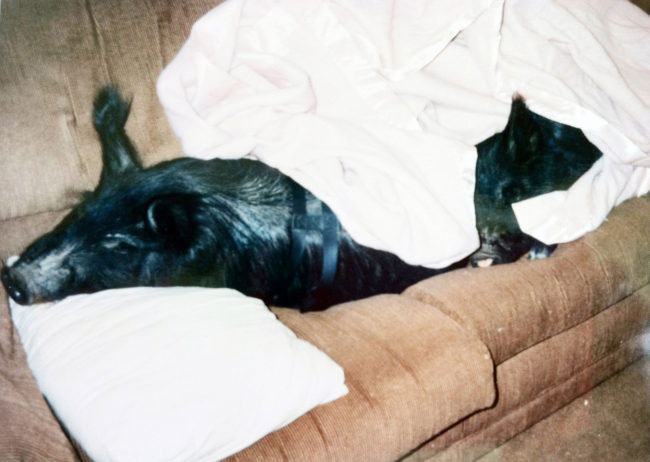 People often ask, “Are you zoned for pigs?” We’re sure we aren’t, so we never bothered to check. Our biggest concern is the next-door neighbors. I went over one day and said that if the pig ever bothers them, to be sure and let me know. (He screams sometimes, but only if you’re trying to bathe or weigh him.)
People often ask, “Are you zoned for pigs?” We’re sure we aren’t, so we never bothered to check. Our biggest concern is the next-door neighbors. I went over one day and said that if the pig ever bothers them, to be sure and let me know. (He screams sometimes, but only if you’re trying to bathe or weigh him.)
“Don’t worry, we will,” said the male neighbor, rather snidely I thought.
“I just wanted to make sure that everything was fine.”
“Well, he hasn’t embarrassed us yet,” said the female neighbor.
I was perplexed. What’s he gonna do? Take off his clothes? (I was still working on teaching him to bend over and bark like a dog.)
So I left the neighbors, thinking it a hopeless cause, but, low and behold, they had a party a month later and actually invited us. I hid Spork in the house, but when I went to the party, all the guests were desperately looking through the fence hoping to get a glimpse of the pig. Admitting that I was “the neighbor with the pig” caused several of the guests to immediately ask the hosts if I could bring Sporky over for a few minutes. (Sensing a party to remember, the neighbors said okay.) Sporky sat and laid down on command and gave the illusion that he was a well-trained animal.
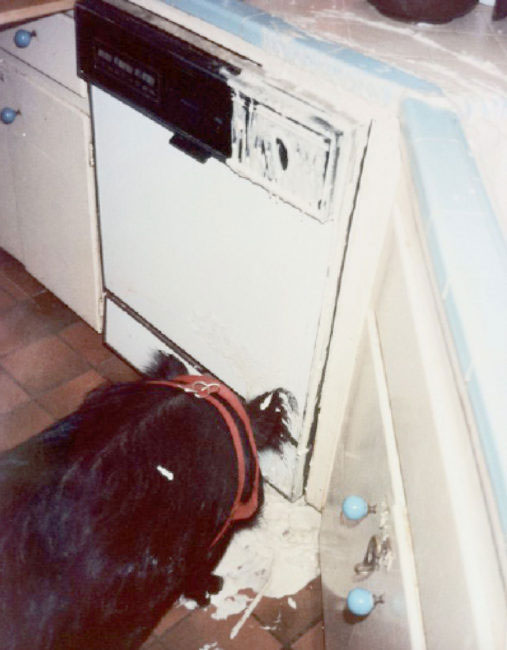
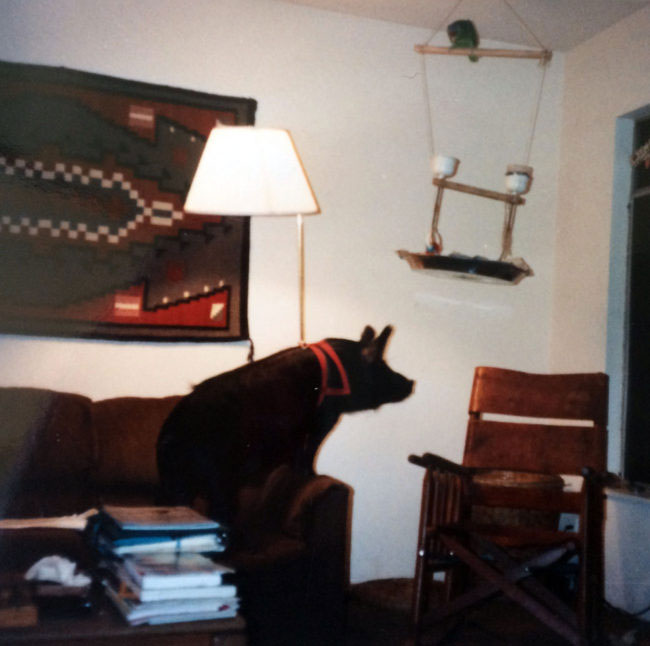
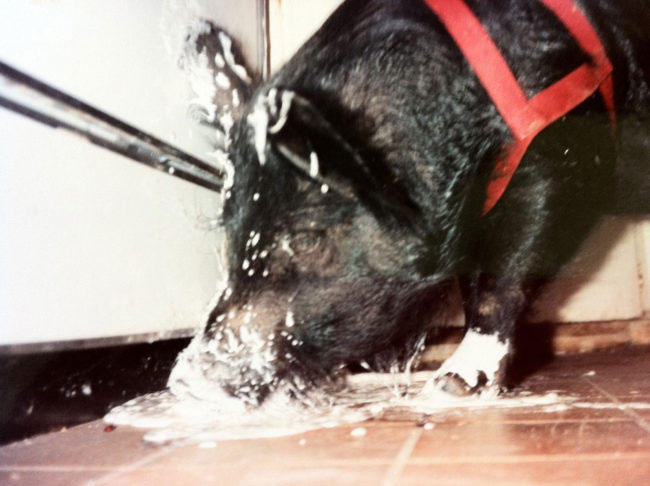 Pigs are extremely trainable as long as you remember that they must be rewarded with food. People find it hard to believe that a pig can be house-broken—and, I have to admit, for awhile, so was I. See, we made the unfortunate decision of letting Sporky pee on newspapers right in a major walkway. We were just so happy he was on the paper, we didn’t want to throw him off by moving them. After awhile, we decided we would like to once again be able to walk from our kitchen to our dining room. So we took a litter box and attached it to a piece of plywood; that way he couldn’t overturn it like he did the first day he was here.
Pigs are extremely trainable as long as you remember that they must be rewarded with food. People find it hard to believe that a pig can be house-broken—and, I have to admit, for awhile, so was I. See, we made the unfortunate decision of letting Sporky pee on newspapers right in a major walkway. We were just so happy he was on the paper, we didn’t want to throw him off by moving them. After awhile, we decided we would like to once again be able to walk from our kitchen to our dining room. So we took a litter box and attached it to a piece of plywood; that way he couldn’t overturn it like he did the first day he was here.
What we didn’t realize is that pigs need room to move around. Just like humans need a warm toilet seat and preferably something to read, pigs need shankroom and a corner to back up to. Consequently, the litter box was a no go (and he would eat the litter). But we weren’t daunted. We finally found him two swimming pools, one for outside wallowing and one for inside pottying. (Fortunately we have a large kitchen.) My husband put the potty pool in the opposite corner of the room from where Sporky was used to going. And he switched willingly—when we were home. But, smart pig that he is, he knew that there was no reason to go in the pool when we’re not home because no one’s there to reward him. (See what I mean about too much intelligence being a bad thing?) Out of desperation, we resorted to that time-tested practice of rubbing his noise in it, even though Swine Times (the newsletter for pig owners) advises most adamantly against it. This only served to make him more obstinate. And I could never succeed in rubbing his nose in it because his neck is so strong (all those rooting muscles); my only choice was to lift him up and make him look at it. Pigs are nearly blind so it hardly seemed worth the backache. One day our frustration came up at our weekly therapy session and the therapist asked, probingly, “Exactly how are you punishing this pig?” (Therapists just love to get their hands on something like this.) She insisted that negative reinforcement does not work, not even on dogs, and that we needed to come up with another solution, like not feeding him when he goes in the wrong place. I said, “Well, there goes the rest of the linoleum.”
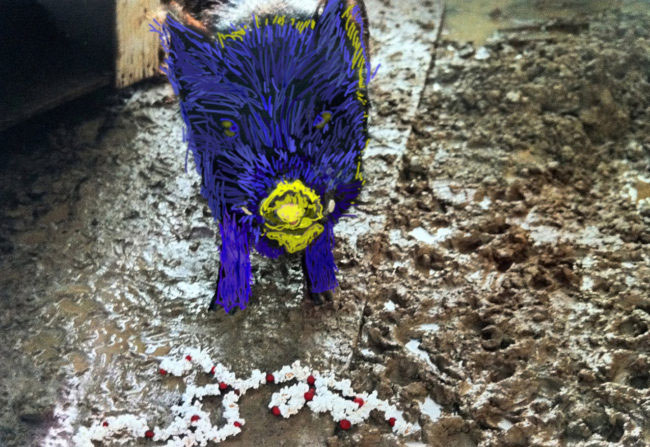
Instead, we hit on the idea of “pig jail,” kind of like time-out for Sporky. Pig jail amounted to two pieces of plywood bisecting our kitchen floor. When he went in the wrong place, it was pig prison until he went in the right place, and then he got out on parole. After about three weeks of this, he was cured. It’s good to see that that therapy is worth something.
Speaking of therapy, we discuss our pig problems with everyone. It seems to make people feel as if they live uncomplicated lives. The other day, a friend’s mother sent us a newspaper clipping of a pig with markings on its side which resembled Mickey Mouse. The caption said that the pig had been purchased by Walt Disney World. This led my husband and I to consider spray painting a weeping Jesus on the side of Spork and advertising him as the swine shrine. Then we thought perhaps of a kneeling Madonna—which led us to consider a squealing Madonna and to wonder which would be a more lucrative sponsor: MTV or the Catholic church. During a Halloween party, someone spray painted the word “SPAM” on the side of Sporky, but that company hasn’t been forthcoming with money.
Money has become a concern only because so many things that Sporky does end up costing us: the library book he ripped apart, the shower door he plowed into, the sofa he ate. (Okay, it was his sofa. We’d go away for the weekend and when we came back, another cushion would be gone and stuffing lay scattered on the floor. We called it Sporky’s craft project.) When people ask if pigs make good pets, I always say, if you’re considering them as a precursor to children, yes. After a pig, children will seem like angels. Even labor looks better to me now.
So for the other questions that people often ask:
“Does he always eat his throw-up like that?”
Disgusting, but true.
“Does he chew gum?”
We think that’s why he threw up.
“Does he come when you call?”
Only if he thinks you might have food.
“Does he get along with other animals?”
I used to think so until he tried to take a bite out of my boss’ dog. (He got slobber all over the dog’s fur. Sporky is more feint than fang, especially since we had the vet saw off his long boar teeth—another thing the pig literature neglected to mention.) Fortunately our company is going out of business or else I would worry about losing my job.
“Can you take him to the beach?”
Of course. All the signs say, “No Dogs.”
“How old will he get?”
Thirty years unless we get hungry. (No, no, no, we wouldn’t eat our pet!)
And finally, people ask the ultimate question, not of the Spork, but of us.
“Do you still eat pork?” (They ask this question like of course the answer is no.)
I tell them, “If the pig has no problem eating bacon, I don’t see why I should.”
“Sporky eats bacon?” they gasp in disbelief.
“Let me tell you, anything that will taste its own urine has no problem eating a member of his extended family.”
“He tastes his own urine?” they gasp, this time in disgust.
“Only if he thinks it might be edible. And he thinks everything is worth trying.”
By now the people move on, leaving us alone. Grossing people out has its advantages.
